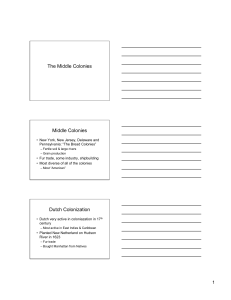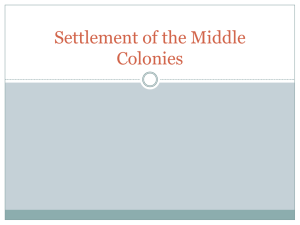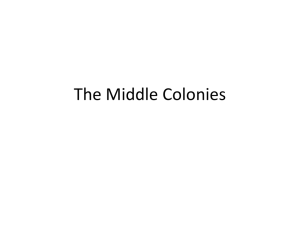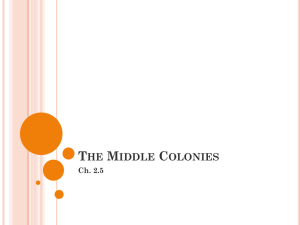The Middle Colonies
advertisement
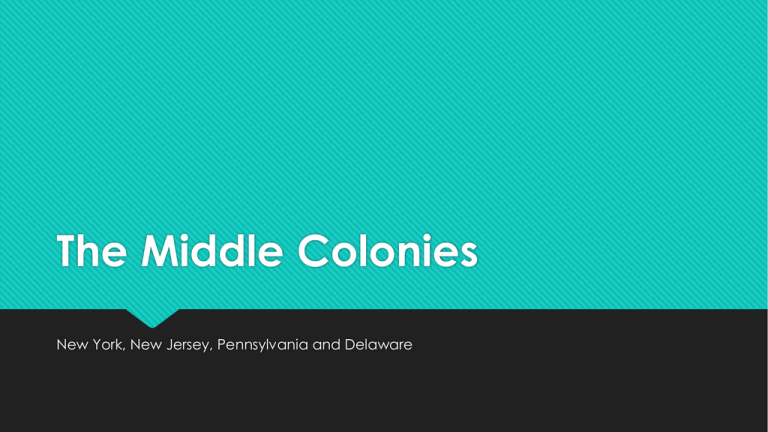
The Middle Colonies New York, New Jersey, Pennsylvania and Delaware Starter – September 3rd List some Puritan beliefs. How did their values shape New England and influence early colonial history? Geography Landscapes ranged from coastal plains to the foothills of the Appalachian Mountains. The waterways of the Middle Colonies were important for trade and transportation. More fertile soils allowed for more productive agriculture. This region became known as the “breadbasket” of the colonies. The natural resources included timber, furs and most importantly agriculture. Henry Hudson He was an English explorer who was paid by the Dutch to explore the present-day coastline of New York. He claims this area for the Dutch in 1609. Hudson River and Hudson Bay are named after him. The Purpose for Settling New Netherland Like the other European colonial powers, the Dutch wanted to establish trading relationships in the New World. In 1624 Peter Minuit purchased Manhattan Island from the Mannahata and established New Amsterdam at the island’s southern tip. The settlement of New Amsterdam solidified the Dutch control of the Hudson River Valley. English Acquisition of New Netherland By the 1660’s, the Dutch were an economic thorn in England’s side. As a result, Charles II ordered the conquest of New Netherland. When the British fleet sailed into New Amsterdam the unpopular governor, Peter Stuyvesant, tried to rally the populous to defend the settlement. (1664) The people refused to fight, thereby surrendering the colony to the British. In 1664 the Duke of York (Charles II’s younger brother) received New Netherland, which is renamed New York in his honor. Sir George Carteret and Lord John Berkeley, close friends of the Duke, were rewarded with a land grant in what is present-day New Jersey. New Netherland become New York Originally named New Netherland because of the Dutch settlers. To attract more people to this area, a patron system was establish. A patron – a person who brought 50 settlers to New Netherland and in return received a large land grant with other special privileges. The Dutch colony of New Amsterdam was a threat to the English colonies to the north and south. New Amsterdam was attacked by the Duke of York and became the proprietary colony of New York. Proprietary Colony – a colony with one owner. William Penn and Pennsylvania William Penn, the son of an admiral, was a member of “The Society of Friends” (Quakers). Penn was given a land grant by King Charles II as repayment of a 16,000 pound-debt the king owed Penn’s father. In 1681 Penn creates the Quaker colony of Pennsylvania (means Penn’s Woods) (Note: Delaware merged with Pennsylvania in 1682. In 1703 Delaware was granted its own assembly.) Why Settle Pennsylvania? William Penn’s Pennsylvania became a “Holy Experiment” Of the Thirteen Colonies, Pennsylvania was by far the most religiously and culturally tolerant because new comers were guaranteed religious and political freedom. Quakers They believed that one could have a personal relationship with God without depending on the clergy. They believed in social equality. They believed everybody was equal in the eyes of God. They believed that women, just as much as men, had the right to speak in meetings. They were pacifists who also opposed slavery. Diversity In the Middle Colonies The Middle Colonies were extremely diverse. − Diversity is a variety of people. The two largest groups living in the Middle Colonies were the English and Germans. Other immigrants included Dutch, Scots-Irish, Africans, Swedish and French. The region’s diversity helped create a climate of tolerance. This means that they honor the religious rights and beliefs of all people. Quakers took it a step further by insisting on the equality of Native Americans and women. Quakers were also the first to speak out against slavery. Middle Colonies Video https://www.youtube.com/watch?v=W7TQL11jHeE


